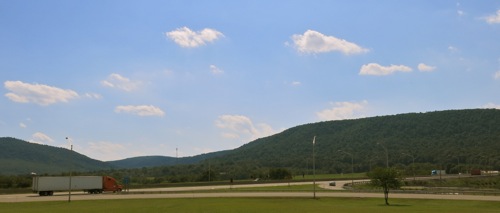The drive from Paoli, Pennsylvania, to Hudson, Ohio, is mostly along the Pennsylvania Turnpike and it is not particularly enjoyable. For most of the distance, the Pennsylvania Turnpike is only two lanes wide, and it carries a lot of truck traffic and a lot of automobile traffic. If you’re driving alone, you don’t have much time to look at the scenery because you’re concentrating on the winding roads and the traffic.
This is too bad, because the scenery is worth looking at. The Turnpike winds up and down and back and forth to get across the Allegheny Mountains, and there are four tunnels, the last of which is almost a mile long — it’s a major engineering feat. This is one of several routes through the Alleghenies that date back to the nineteenth century when various interests were competing to connect eastern Pennsylvania with the west. After the American Revolution ended, Americans started pushing west through Pennsylvania, but “in these early years, terrible roads were the norm; they were rudimentary, often badly built, poorly graded, and seldom maintained.” (Robert Kapsch, Over the Alleghenies: Early Canals and Railroads of Pennsylvania [Morgantown, W.V.: West Virginia Univ. Press, 2013], p. 13).
By 1824, the Commonwealth of Pennsylvania was making plans for building a canal from Philadelphia to Pittsburg, in order to make travel across the mountains easier. One early plan called for a canal “40 feet wide at the top, 24 feet wide at the bottom, and four feet deep” to get through and across the mountains; “to accomplish the most difficult portion, a canal over the Alleghenies, … the commissioners proposed a tunnel [over] 4 miles long” (Kapsch, pp. 52-52). As amazing as it sounds, canals were built through this rugged terrain; these canals mostly followed rivers, but there were sections of canals to be dug, locks to be built on the rivers, aqueducts and tunnels that had to be constructed — and most of the work had to be done by hand, in those early days.
Hearing about the early canals and railroads makes the construction of the Pennsylvania Turnpike seem less impressive. Imagine getting a canal boat through the mountains — after thinking about that, the winding grades that require semi-trailers to grind upwards in low gear with flashers on are not at all impressive.

Aside from the scenery — which I did not have time to look at — aside from the scenery, the Pennsylvania Turnpike is not a pleasant highway to drive: enough traffic to be annoying, too many poor drivers, service areas that range from cheerless to grim. But it was worth the drive because I got to visit with cousins and an uncle in Pennsylvania, and tomorrow I will visit with cousins and an uncle in Ohio. Sometimes the point of the journey is not the journey, but the destination.
Posted several days late, due to lack of good Internet access.
